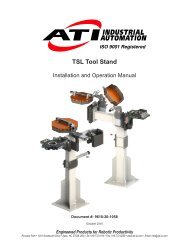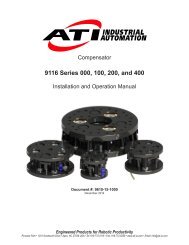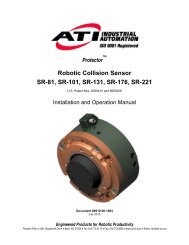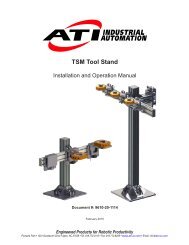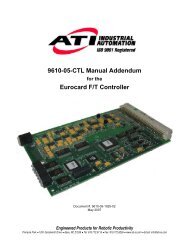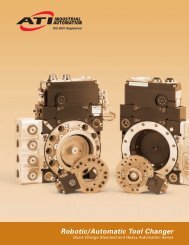Network Force/Torque Sensor System
Net F/T Manual - ATI Industrial Automation
Net F/T Manual - ATI Industrial Automation
You also want an ePaper? Increase the reach of your titles
YUMPU automatically turns print PDFs into web optimized ePapers that Google loves.
Net F/T Installation and Operation Manual<br />
Document: 9620-05-net ft-11<br />
10. UDP Interface Using RDT<br />
The Net F/T can output data at up to 7000 Hz over Ethernet using UDP. This method of fast data collection is<br />
called Raw Data Transfer (RDT). If the overhead of DeviceNet or EtherNet/IP is too much for your project, or<br />
you need extra speed in your data acquisition, RDT provides an easy method to get the forces, torques, and<br />
status codes of the Net F/T system.<br />
NOTICE: Multi-byte values must be transferred to the network high byte first and with the correct<br />
number of bytes. Some compilers align structures to large field sizes, such as 32- or 64-bit fields,<br />
and send an incorrect number of bytes. C compilers usually provide the functions htons(), htonl(),<br />
ntohs(), and ntohl() that can automatically handle these issues.<br />
10.1 RDT Protocol<br />
There are six commands in the RDT protocol. These are listed in Table 10.1—RDT Commands. Any<br />
command received by the Net F/T will take precedence over any previously-received commands.<br />
Table 10.1—RDT Commands<br />
Command Command Name Command Response<br />
0x0000 Stop streaming none<br />
0x0002<br />
0x0003<br />
0x0004<br />
Start high-speed real-time<br />
streaming<br />
Start high-speed buffered<br />
streaming<br />
Start multi-unit streaming<br />
(synchronized)<br />
RDT record(s)<br />
RDT record(s)<br />
RDT record(s)<br />
0x0041 Reset Threshold Latch none<br />
0x0042 Set Software Bias none<br />
The three streaming modes are further described in Table 10.2—Streaming Modes.<br />
Table 10.2—Streaming Modes<br />
Mode Command Speed Situation Best Suited To<br />
0x0002<br />
Start high-speed real-time<br />
streaming<br />
Fast (up to 7000 Hz)<br />
Real-time response applications.<br />
0x0003<br />
Start high-speed buffered<br />
streaming<br />
Fast (up to 7000 Hz), but comes<br />
in bursts (buffers)<br />
Collecting data at high speed, but not<br />
responding to it in real-time. Buffer size<br />
is set on the Communication Settings<br />
web page. See Section 4.8—<br />
Communications Settings Page<br />
(comm..htm).<br />
0x0004<br />
Start multi-unit streaming<br />
(synchronized)<br />
Slower, depending on the<br />
number of sensor systems<br />
involved<br />
Multi-unit synchronization. The multi-unit<br />
ID number is set on the Communication<br />
Settings web page.<br />
To start the Net F/T outputting RDT messages, you first send an RDT request to it. The Net F/T listens<br />
for RDT requests on UDP port 49152. It also sends the RDT output messages from this port.<br />
Pinnacle Park • 1031 Goodworth Drive • Apex, NC 27539 USA • Tel: +1.919.772.0115 • Fax: +1.919.772.8259 • www.ati-ia.com • Email: info@ati-ia.com<br />
B - 73



